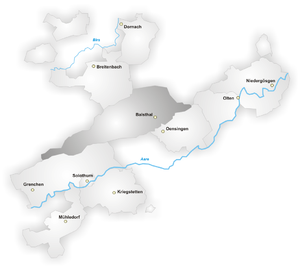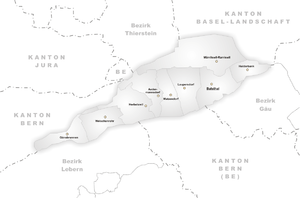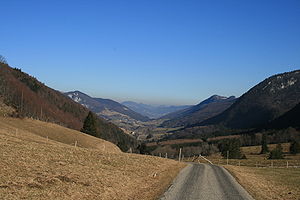
Thal (district)
Encyclopedia



Cantons of Switzerland
The 26 cantons of Switzerland are the member states of the federal state of Switzerland. Each canton was a fully sovereign state with its own borders, army and currency from the Treaty of Westphalia until the establishment of the Swiss federal state in 1848...
of Solothurn in Switzerland
Switzerland
Switzerland name of one of the Swiss cantons. ; ; ; or ), in its full name the Swiss Confederation , is a federal republic consisting of 26 cantons, with Bern as the seat of the federal authorities. The country is situated in Western Europe,Or Central Europe depending on the definition....
, situated in the centre of the canton. Together with the Gäu District
Gäu (district)
Gäu District is one of the ten districts of the canton of Solothurn in Switzerland, situated in the centre of the canton. It has a population of...
, it forms the Amtei (electoral district) of Thal-Gäu. It has a population of (as of ).
Municipalities
Thal District contains the following municipalities:! align="center" valign="center" bgcolor="#EFEFEF" | Area, km²
|-
| align="center" |

Aedermannsdorf
Aedermannsdorf is a municipality in the district of Thal in the canton of Solothurn in Switzerland.-Geography:Aedermannsdorf has an area, , of . Of this area, or 49.5% is used for agricultural purposes, while or 46.7% is forested...
|| align="center" |
| align="right" | 12.88
|-
| align="center" |

Balsthal
Balsthal is a municipality in the district of Thal in the canton of Solothurn in Switzerland.-History:Balsthal is first mentioned in 968 as Palcivallis. In 1255 it was mentioned as Balcetal.-Geography:...
|| align="center" |
| align="right" | 15.69
|-
| align="center" |

Gänsbrunnen
Gänsbrunnen is a municipality in the district of Thal in the canton of Solothurn in Switzerland. The French name for Gänsbrunnen is Saint-Joseph.Gänsbrunnen is one of the smallest municipalities in Solothurn.-Geography:...
|| align="center" |
| align="right" | 11.36
|-
| align="center" |

Herbetswil
Herbetswil is a municipality in the district of Thal in the canton of Solothurn in Switzerland.-Geography:Herbetswil has an area, , of . Of this area, or 34.8% is used for agricultural purposes, while or 61.9% is forested...
|| align="center" |
| align="right" | 16.35
|-
| align="center" |

Holderbank, Solothurn
Holderbank is a municipality in the district of Thal in the canton of Solothurn in Switzerland.-Geography:Holderbank has an area, , of . Of this area, or 44.3% is used for agricultural purposes, while or 49.5% is forested...
|| align="center" |
| align="right" | 7.79
|-
| align="center" |

Laupersdorf
Laupersdorf is a municipality in the district of Thal in the canton of Solothurn in Switzerland.-History:Laupersdorf is first mentioned in 968 as Luiperestorf which comes from an 11th Century copy of the earlier document. In 1179 it was mentioned as de Loppestorf.-Geography:Laupersdorf has an...
|| align="center" |
| align="right" | 15.52
|-
| align="center" |

Matzendorf
Matzendorf is a municipality in the district of Thal in the canton of Solothurn in Switzerland.-History:Matzendorf is first mentioned in 968 as Mazendorf though this comes from an 11th Century copy of the earlier document. In 1227 it was mentioned as apud Macindorf.-Geography:Matzendorf has an...
|| align="center" |
| align="right" | 11.29
|-
| align="center" |

Mümliswil-Ramiswil
Mümliswil-Ramiswil is a municipality in the district of Thal in the canton of Solothurn in Switzerland.-History:Mümliswil is first mentioned in 1145 as Mumliswilre and Mumliswilere. In 1194 it was mentioned as Mumeliswile...
|| align="center" |
| align="right" | 35.48
|-
| align="center" |

Welschenrohr
Welschenrohr is a municipality in the district of Thal in the canton of Solothurn in Switzerland.-History:Welschenrohr is first mentioned in 1179 as Rore. An important watch manufacturing place up to the 1960s, its economy was heavily affected by the late 1960s watch crisis...
|| align="center" |
| align="right" | 12.97
|-
|- style="background-color:#EFEFEF;"
| align="center" |
| bgcolor="#EFEFEF" | Total || bgcolor="#EFEFEF" align="center" |
| bgcolor="#EFEFEF" align="right" | 139.33
|}
Geography
Thal has an area, , of 139.34 square kilometres (53.8 sq mi). Of this area, 57.91 km² (22.4 sq mi) or 41.6% is used for agricultural purposes, while 72.74 km² (28.1 sq mi) or 52.2% is forested. Of the rest of the land, 8.03 km² (3.1 sq mi) or 5.8% is settled (buildings or roads), 0.26 km² (0.100386561234059 sq mi) or 0.2% is either rivers or lakes and 0.4 km² (0.154440863437014 sq mi) or 0.3% is unproductive land.Of the built up area, housing and buildings made up 2.9% and transportation infrastructure made up 1.9%. Out of the forested land, 49.6% of the total land area is heavily forested and 2.6% is covered with orchards or small clusters of trees. Of the agricultural land, 27.6% is used for growing crops and 13.3% is used for alpine pastures. All the water in the district is flowing water.
Coat of arms
The blazonBlazon
In heraldry and heraldic vexillology, a blazon is a formal description of a coat of arms, flag or similar emblem, from which the reader can reconstruct the appropriate image...
of the municipal coat of arms
Coat of arms
A coat of arms is a unique heraldic design on a shield or escutcheon or on a surcoat or tabard used to cover and protect armour and to identify the wearer. Thus the term is often stated as "coat-armour", because it was anciently displayed on the front of a coat of cloth...
is Gules a Falcon Argent displayed stantant on a rock issuant of the same.
Demographics
Thal has a population of .Most of the population speaks German
German language
German is a West Germanic language, related to and classified alongside English and Dutch. With an estimated 90 – 98 million native speakers, German is one of the world's major languages and is the most widely-spoken first language in the European Union....
(12,734 or 90.7%), with Serbo-Croatian
Serbo-Croatian
Serbo-Croatian or Serbo-Croat, less commonly Bosnian/Croatian/Serbian , is a South Slavic language with multiple standards and the primary language of Serbia, Croatia, Bosnia and Herzegovina, and Montenegro...
being second most common (283 or 2.0%) and Albanian
Albanian language
Albanian is an Indo-European language spoken by approximately 7.6 million people, primarily in Albania and Kosovo but also in other areas of the Balkans in which there is an Albanian population, including western Macedonia, southern Montenegro, southern Serbia and northwestern Greece...
being third (266 or 1.9%). There are 78 people who speak French
French language
French is a Romance language spoken as a first language in France, the Romandy region in Switzerland, Wallonia and Brussels in Belgium, Monaco, the regions of Quebec and Acadia in Canada, and by various communities elsewhere. Second-language speakers of French are distributed throughout many parts...
and 8 people who speak Romansh.
, the gender distribution of the population was 51.2% male and 48.8% female. The population was made up of 5,958 Swiss men (41.6% of the population) and 1,367 (9.5%) non-Swiss men. There were 5,863 Swiss women (40.9%) and 1,131 (7.9%) non-Swiss women. Of the population in the district 6,483 or about 46.2% were born in Thal and lived there in 2000. There were 2,888 or 20.6% who were born in the same canton, while 2,402 or 17.1% were born somewhere else in Switzerland, and 1,869 or 13.3% were born outside of Switzerland.
In there were 92 live births to Swiss citizens and 35 births to non-Swiss citizens, and in same time span there were 109 deaths of Swiss citizens and 10 non-Swiss citizen deaths. Ignoring immigration and emigration, the population of Swiss citizens decreased by 17 while the foreign population increased by 25. There were 26 Swiss men and 13 Swiss women who immigrated back to Switzerland. At the same time, there were 81 non-Swiss men and 46 non-Swiss women who immigrated from another country to Switzerland. The total Swiss population change in 2008 (from all sources, including moves across municipal borders) was a decrease of 104 and the non-Swiss population increased by 121 people. This represents a population growth rate of 0.1%.
, there were 5,757 people who were single and never married in the district. There were 6,828 married individuals, 903 widows or widowers and 550 individuals who are divorced.
There were 1,530 households that consist of only one person and 556 households with five or more people. Out of a total of 5,540 households that answered this question, 27.6% were households made up of just one person and 64 were adults who lived with their parents. Of the rest of the households, there are 1,571 married couples without children, 1,968 married couples with children There were 249 single parents with a child or children. There were 66 households that were made up unrelated people and 92 households that were made some sort of institution or another collective housing.
The historical population is given in the following chart:
Politics
In the 2007 federal electionSwiss federal election, 2007
Elections to the Swiss Federal Assembly, the federal parliament of Switzerland, were held on Sunday, 21 October 2007. In a few cantons, a second round of the elections to the Council of States was held on 11 November, 18 November, and 25 November 2007...
the most popular party was the CVP
Christian Democratic People's Party of Switzerland
The Christian Democratic People's Party of Switzerland is a Christian democratic political party in Switzerland. It is the fourth-largest party in the National Council, with 31 seats, and the largest in the Council of States, with 15 seats. It has one seat, that of Doris Leuthard, on the Swiss...
which received 34.6% of the vote. The next three most popular parties were the SVP
Swiss People's Party
The Swiss People's Party , also known as the Democratic Union of the Centre , is a conservative political party in Switzerland. Chaired by Toni Brunner, but spearheaded by Christoph Blocher, the party is the largest party in the Federal Assembly, with 58 members of the National Council and 6 of...
(30.2%), the FDP
FDP.The Liberals
FDP.The Liberals is a classical liberal political party in Switzerland. It is the joint-largest party in the Federal Council, third-largest party in the National Council, and second-largest in the Council of States....
(19.55%) and the SP
Social Democratic Party of Switzerland
The Social Democratic Party of Switzerland is the largest centre-left political party in Switzerland....
(9.45%). In the federal election, a total of 5,474 votes were cast, and the voter turnout
Voter turnout
Voter turnout is the percentage of eligible voters who cast a ballot in an election . After increasing for many decades, there has been a trend of decreasing voter turnout in most established democracies since the 1960s...
was 56.4%.
Religion
From the , 8,990 or 64.0% were Roman Catholic, while 2,525 or 18.0% belonged to the Swiss Reformed ChurchSwiss Reformed Church
The Reformed branch of Protestantism in Switzerland was started in Zürich by Huldrych Zwingli and spread within a few years to Basel , Bern , St...
. Of the rest of the population, there were 233 members of an Orthodox church
Orthodox Christianity
The term Orthodox Christianity may refer to:* the Eastern Orthodox Church and its various geographical subdivisions...
(or about 1.66% of the population), there were 16 individuals (or about 0.11% of the population) who belonged to the Christian Catholic Church
Christian Catholic Church of Switzerland
The Christian Catholic Church of Switzerland is the Swiss member church of the Union of Utrecht, also known as Old Catholic Church, originally founded by the jansenists, with a later influx of discontented Catholics following their disappointment with the First Vatican Council. It has 14,000...
, and there were 188 individuals (or about 1.34% of the population) who belonged to another Christian church. There were 816 (or about 5.81% of the population) who were Islam
Islam
Islam . The most common are and . : Arabic pronunciation varies regionally. The first vowel ranges from ~~. The second vowel ranges from ~~~...
ic. There were 42 individuals who were Buddhist
Buddhism
Buddhism is a religion and philosophy encompassing a variety of traditions, beliefs and practices, largely based on teachings attributed to Siddhartha Gautama, commonly known as the Buddha . The Buddha lived and taught in the northeastern Indian subcontinent some time between the 6th and 4th...
, 13 individuals who were Hindu
Hinduism
Hinduism is the predominant and indigenous religious tradition of the Indian Subcontinent. Hinduism is known to its followers as , amongst many other expressions...
and 9 individuals who belonged to another church. 889 (or about 6.33% of the population) belonged to no church, are agnostic
Agnosticism
Agnosticism is the view that the truth value of certain claims—especially claims about the existence or non-existence of any deity, but also other religious and metaphysical claims—is unknown or unknowable....
or atheist
Atheism
Atheism is, in a broad sense, the rejection of belief in the existence of deities. In a narrower sense, atheism is specifically the position that there are no deities...
, and 317 individuals (or about 2.26% of the population) did not answer the question.
Education
In Thal about 5,109 or (36.4%) of the population have completed non-mandatory upper secondary education, and 1,019 or (7.3%) have completed additional higher education (either University or a FachhochschuleFachhochschule
A Fachhochschule or University of Applied Sciences is a German type of tertiary education institution, sometimes specialized in certain topical areas . Fachhochschulen were founded in Germany and later adopted by Austria, Liechtenstein, Switzerland and Greece...
). Of the 1,019 who completed tertiary schooling, 73.9% were Swiss men, 16.0% were Swiss women, 5.9% were non-Swiss men and 4.2% were non-Swiss women.
During the 2010-2011 school year there were a total of 532 students in the Thal school system. The education system
Education in Switzerland
The education system in Switzerland is very diverse, because the constitution of Switzerland delegates the authority for the school system mainly to the cantons...
in the Canton of Solothurn allows young children to attend two years of non-obligatory Kindergarten
Kindergarten
A kindergarten is a preschool educational institution for children. The term was created by Friedrich Fröbel for the play and activity institute that he created in 1837 in Bad Blankenburg as a social experience for children for their transition from home to school...
. During that school year, there were no children in the district kindergarten. The canton's school system requires students to attend six years of primary school, with some of the children attending smaller, specialized classes. In the district there were no students in primary school and 26 students in the special, smaller classes. The secondary school
Secondary school
Secondary school is a term used to describe an educational institution where the final stage of schooling, known as secondary education and usually compulsory up to a specified age, takes place...
program consists of three lower, obligatory years of schooling, followed by three to five years of optional, advanced schools. 506 lower secondary students attend school in the Thal district schools.

